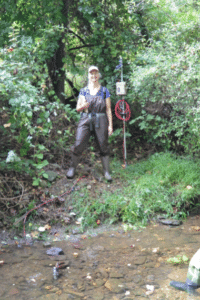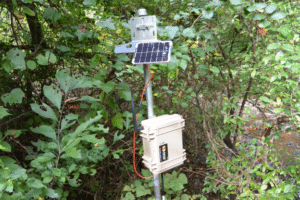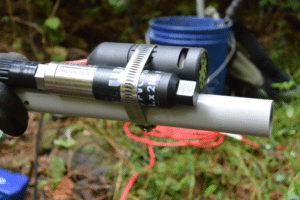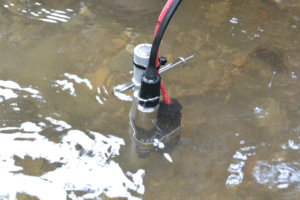In the summer of 2016, Shannon Hicks and other Stroud Water Research Center (SWRC) staff kept busy deploying dozens of sensor stations based on our new EnviroDIY Mayfly Data Logger. Most recently, we collaborated with The Nature Conservancy, to install EnviroDIY Mayfly automated sensor stations on streams located in Delaware’s First State National Historic Park (FSNHP). Sensor stations were installed in September at three sites — on Ramsey Creek, on Rocky Creek, and on Beaver Creek — which are all tributaries to Brandywine Creek. Each of the sensor stations were equipped with a
Decagon Devices CTD-10 sensor to measure electrical conductivity, temperature, depth and with a Campbell Scientific OBS-3+ sensor to measure turbidity. Every 5 minutes, the Mayfly logger collects data from the sensors and transmits the data to our web servers using a GPRSbee rev.6 cell wireless module that neatly fits into the XBee radio socket on the Mayfly board. These GPRS radios make it easy to send sensor data over our local cell phone networks, especially when paired with inexpensive SIM cards from Hologram.
- An example of a Mayfly sensor station deployed in a stream.
 Under the guidance of Stroud Water Research Center staff, the sensor stations at FSNHP and associated data will be managed by Kim Hachadoorian, the Delaware Nature Conservancy’s Stream Stewards Project Manager and her Stream Stewards volunteer crew. The stations were strategically positioned to support monitoring of current and planned conservation practices in and around the national park. Results are intended to assist The Nature Conservancy of Delaware in working with FSNHP to manage park resources and the local landscape.
Under the guidance of Stroud Water Research Center staff, the sensor stations at FSNHP and associated data will be managed by Kim Hachadoorian, the Delaware Nature Conservancy’s Stream Stewards Project Manager and her Stream Stewards volunteer crew. The stations were strategically positioned to support monitoring of current and planned conservation practices in and around the national park. Results are intended to assist The Nature Conservancy of Delaware in working with FSNHP to manage park resources and the local landscape.
In addition to these sensor stations, we upgraded most of our existing sensor stations to the Mayfly board from the previous generation of rugged datalogger based on the Seeeduino Stalker, and we deployed two *remote* stations in the north woods of Minnesota in collaborations with our colleagues at the University of Minnesota, Diana Karwan (former SWRC Post Doc!) and Lucy Rose.
Live data from these stations can be viewed at our prototype data portal. Stay tuned for news on our new EnviroDIY Data Sharing Portal what we’ll be unveiling this winter!
— Thanks to David Bressler, Shannon Hicks, and Steve Kerlin for helping prepare this post!

 Welcome to EnviroDIY, a community for do-it-yourself environmental science and monitoring. EnviroDIY is part of
Welcome to EnviroDIY, a community for do-it-yourself environmental science and monitoring. EnviroDIY is part of 


Very nice project!
Do you have an exemple code with the GPRSbee. I use GPRSbee rev6b + stalker V3.1 but I have some problem with the gprsbee.init.
Thank you,
Eric
We’re working on getting an example sketch for the stations shown in this post, using the GPRSbee cell phone wireless ratio. We’re also working on getting as much code as possible in our EnviroDIY GitHub code repository for the Mayfly: https://github.com/EnviroDIY/EnviroDIY_Mayfly_Logger
Stay tuned!
This might be helpful: http://forum.sodaq.com/t/gprsbee-library/471
Dear Anthony, congratulations. Based on the pictures, I have following practical questions:
1) What solar panel are you using? The solar panel that comes with the Mayfly is much smaller.
2) Is it acustic material that you use to fill up the space in the box? Has it any other function?
With friendly greetings,
Arnoud
The solar panels in the photos above are made by a company called Voltaic Systems (https://www.voltaicsystems.com/solar-panels). They have a variety of sizes, we prefer the 2W for sunny areas, and 3.5W for shady areas. T he small 0.5w panel that comes with the Mayfly starter kit is not waterproof, but it’s handy if you want to build a small logger and put the panel inside the clear lid of the small Mayfly enclosure.
The Pelican cases we use for our loggers come with foam already inside them, so you simply cut away part of the foam to create spaces for the logger, battery, cables, etc.
That looks very nice. Did you have any ESD-problems with that foam and those cases? I’ve tried to use some fake pelican boxes (made of PE plastic I belive) as enclosures for electronics and had huge problems; as soon as I came close to the box the electronics went crazy.
No, I haven’t had any problems with the foam or the cases. In fact, in some of the loggers in locations with a strong cellular signal, I skip the external antenna for the GPRS module and simply use a small PCB antenna and simply tuck that antenna between the small Mayfly enclosure and the foam.
HI, do you have a diagram or wiring map so I can understand how to connect the OBS sensor to the mayfly data logger please?
Hi @Walter,
I haven’t deployed an OBS, but it looks like it goes into the I2C port using the instructions at:
https://github.com/EnviroDIY/ModularSensors#campbell-scientific-obs-3
where it says that, “The power supply is connected to the red wire, low range output comes from the blue wire, high range output comes from the white wire, and the black, green, and silver/unshielded wires should all be connected to ground.”
Beth, thanks for sending Walter the links to the sensor description in the Modular Sensors library ReadMe file! That is a great resource.
One important correction, the Campbell Sci. OBS3+ sensor is an ANALOG sensor, and therefore should be connected to one of the Aux Analog grove ports on the Mayfly’s lower left side. The Auxiliary Analog-to-Digital Converter (ADC) chip is, however, an I2C device, which is why the description mentions I2C.
Walter, if you read that ModularSensors sensor description carefully, you’ll also see that the OBS3+ works better with 5V of power, so you should move the power jumper on the Mayfly for the Aux Analog from switched 3.3V to switched 5V.
Thanks a lot Anthony / Fisherba, I will work on the MayFly and the OBS on the weekend!.
Hi fisherba, thanks a lot for the help, as soon I arrive to my office will work on it. I will like to ask you if you had work with any turbidity sensor in special?, I’m looking to deploy at last 14 of those sensor spread out in fresh water tanks.
Hi @Walter, I completely missed this turbidity question. We have used Yosimetech (http://www.yosemitech.com/en/) turbidity sensors, but there’s enough hassle in ordering (customs hang-ups every time) and creating a RS-485 shield to communicate with those, that going with the Campbell sensor might be in my future.